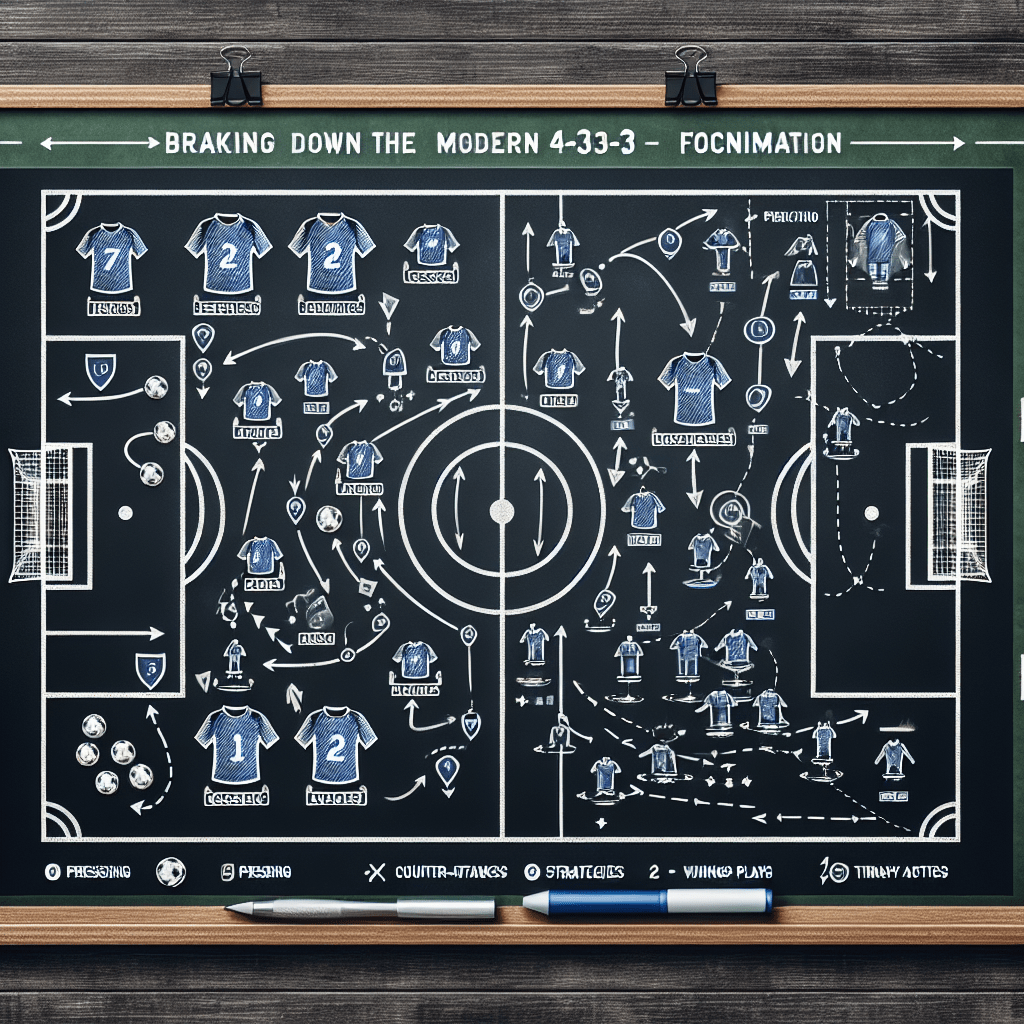[ad_1]
# Breaking Down the Modern 4-3-3 Formation: A Comprehensive Soccer Tactics Analysis
## Introduction
The 4-3-3 formation has become one of the most prominent and successful formations in modern soccer, known for its versatility, dynamic attacking options, and solid defensive structure. It has been adapted by some of the world’s top clubs and national teams, leading to significant successes on the international stage. This comprehensive analysis dives into the intricacies of the modern 4-3-3 formation, exploring its evolution, tactical flexibility, and key components that make it a preferred choice among elite coaches.
## Historical Context
The 4-3-3 formation has its roots in the total football philosophy of the 1970s Dutch national teams. It evolved as a tactical response to the rigid 4-4-2, offering more fluidity in attack and defense. Over the years, it has been refined, allowing teams to exploit spaces in the midfield and flanks more efficiently while maintaining a strong defensive backbone.
## Tactical Flexibility
One of the most significant advantages of the 4-3-3 is its tactical flexibility. Teams can adjust the roles of the midfield trio and the front three to either focus on possession, counter-attacking, or a balanced approach. The formation can seamlessly transition to a 4-5-1 during defensive phases, providing extra cover in the midfield and making it difficult for opponents to break down.
### Attacking Phase
In attack, the 4-3-3 allows for width, depth, and verticality. The wingers stretch the play, creating spaces for the midfielders or full-backs to exploit. The central forward can drop deep, pulling defenders out of position and opening channels for midfield runners or overlapping full-backs. This phase emphasizes on quick, vertical passes to break the lines or wide plays to disorient the opponent’s defensive structure.
### Defensive Phase
Defensively, the 4-3-3 relies on pressing and compactness. The front three press the opponent’s defenders, forcing them to play long balls or make mistakes. The midfield trio focuses on controlling the central areas, with at least one player always ready to drop back and support the defense. The full-backs adopt a more conservative role, narrowing the defensive line and working in tandem with the center-backs to cover lateral threats.
## Key Components
The effectiveness of the 4-3-3 formation hinges on several key components and roles within the team:
### Goalkeeper
The modern goalkeeper in a 4-3-3 is not just the last line of defense but also the first point of attack. They must be comfortable with the ball at their feet, capable of playing passes under pressure to start the buildup from the back.
### Defenders
The central defenders need to be strong in the air and skilled in one-on-one situations. Moreover, their ability to play out from the back under pressure is crucial. Full-backs in a 4-3-3 are essentially wide midfielders, contributing to both defense and attack. They provide width, support the wingers, and make overlapping or underlapping runs.
### Midfielders
The midfield trio usually consists of a defensive midfielder (No.6) and two central midfielders (No.8s). The No.6 acts as a screen for the defense and a pivot in possession, facilitating the transition from defense to attack. The No.8s need to be dynamic, capable of contributing to both defensive duties and attacking movements, often making late runs into the box.
### Forwards
The forwards are composed of two wingers and a central striker. Wingers in the modern 4-3-3 are not just limited to providing crosses; they need to be versatile, capable of cutting in, taking shots, and even playing in a more inverted role. The central striker acts as the focal point of the attack, holding up play, and making runs behind the defense.
## Successful Implementations
Pep Guardiola’s Barcelona, Jurgen Klopp’s Liverpool, and Hansi Flick’s Bayern Munich are prime examples of teams that have masterfully implemented the 4-3-3 formation. Each team adapted the basic structure to suit their player’s strengths, showcasing the formation’s adaptability and effectiveness.
## Challenges
The 4-3-3 formation is not without its challenges. Teams employing highly effective pressing tactics can disrupt the buildup play, especially if the goalkeeper and defenders are less proficient with the ball. Additionally, a well-organized 4-4-2 can pose problems in midfield, neutralizing the central trio and forcing the team into wide areas.
## FAQs
### How does the 4-3-3 differ from the 4-5-1?
– The 4-3-3 focuses more on attacking, with a front three that actively engages in high pressing, whereas the 4-5-1 is more defensively oriented, with the midfield five focusing on control and compactness.
### Can the 4-3-3 be effective against a 3-5-2 formation?
– Yes, the 4-3-3 can be effective against a 3-5-2 by exploiting the wide areas. The wingers can stretch the three-man defense, creating spaces for midfield runners or full-back overlaps.
### What type of players are ideal for the central midfield roles in a 4-3-3?
– The ideal players for the central midfield roles are versatile, able to defend, pass, and drive forward with the ball. A blend of defensive solidity, creativity, and energy is crucial.
### How important is the goalkeeper in a 4-3-3 formation?
– Extremely important. The goalkeeper in a 4-3-3 acts as an 11th outfield player, involved in the buildup play and required to be comfortable with distributing under pressure.
## Conclusion
The modern 4-3-3 formation is a testament to the evolution of soccer tactics, offering a balanced approach that can be adapted to highlight a team’s strengths and mitigate weaknesses. Its success on the global stage is a tribute to its versatility, demanding a blend of tactical discipline, player skill, and coaching acumen. As soccer continues to evolve, so too will the interpretations and implementations of the 4-3-3, solidifying its place in the tactical annals of the sport.
[ad_2]






